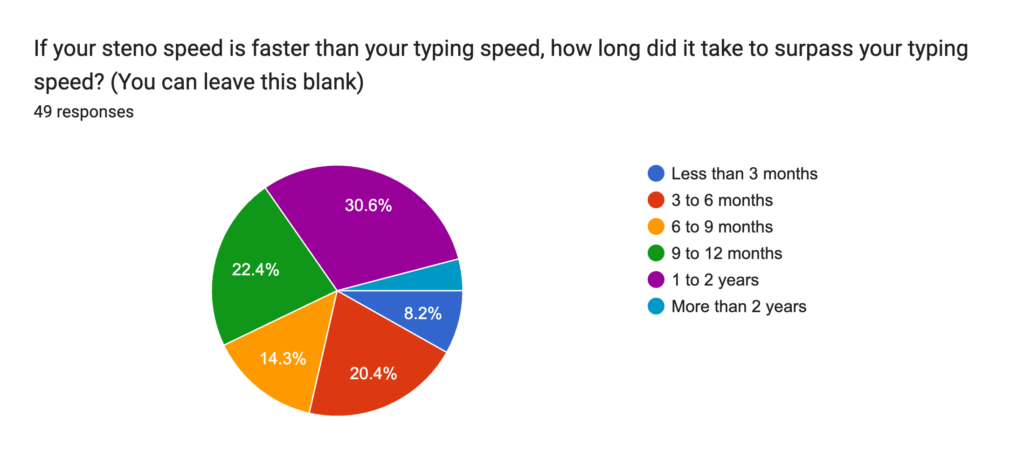
The Open Steno Project organised a survey, and they were kind enough to share the results (and also as a spreadsheet). It’s a census, asking a few questions about users of stenography-related devices and software, and their preferences therein. Below is a summary of most of the questions, with some key takeaways at the bottom of this post.
I discovered an earlier census only later while doing the writeup, and I haven’t compared all the answers between the two surveys. Whoops!
Background
- The survey in total had 190 responses. That’s a pretty good turnout, though I don’t know how many users the Plover Discord (where the survey was shared) has exactly. At the time of writing, 1051 users were online. If the splitkb.com server is any reference, that might mean the Plover server as a whole has about 5000 members, so roughly 4% would have responded to the survey. A rough guess!
- The previous survey I could find was hosted in 2022, and saw 83 responses. That means that with the passing of two years, the number of respondents more than doubled. Nice growth!
- The majority of respondents are young adults. They’re aged between 18-25 (37.9%) followed by 26 to 35 (32.1%). Another 10.5% were aged below 18, meaning 80.5% of all respondents were below the age of 35 in total. In 2022, that was 73.5% in total, so the community is getting younger.
- The majority of respondents live in the United States, with 52.1%. The next biggest region was Europe, at 18.4%.
- There’s a pretty even distribution in the length at which users have been learning stenography. In total, 52.7% was learning for a less than a year. There’s likely some survivorship bias here, as the people who quit learning are unlikely to have filled in the survey.
- The vast majority writes steno pretty slowly, with people just starting out below 20WPM sitting at 35.6%, and another 13.8% sitting between 20-40WPM. The remainer, 50.6%, are all writing at above 40WPM. Average English speakers speak at a rate of around 140WPM, and if we include the 120WPM category, then 15,5% of the respondents can keep up, which stenography was meant for. Interestingly, when looking at normal, non-stenography typing speeds, then 14,1% of the respondents can type at similar speeds. And that’s pretty fast!
- About a quarter of the people use a non-standard keyboard layout on their normal keyboard. Of those, 8% use Dvorak and another 8% use Colemak, and then there’s a long tail of a variety of layouts, from custom-made layouts to chord-based input devices.
- About a quarter of the people claim they write faster using stenography than they can type with a keyboard. Of those, 4 people learned to do so within 3 months, 10 people within 6 months, and another 7 people within 9 months. All in all, though, it’s more realistic to practise for 9 months or more, representing over half of the people. There’s quite a learning curve, after all.

- Social media is the most powerful driver for community growth. Not a big shocker in of itself, but it’s interesting to see how single events such as Mirabai’s talk at Pycon (20.4%) and a particular video on a stenography keyboard (11.2%) represented a lot of growth, while the biggest overal factor was stenography-related content creators on YouTube with 24.2%. It turns out that key content can be a significant driver – maybe the Pareto Principle (80/20 rule) applies here, too.
- Willingness to type fast seems the most dominant motivation for people to learn stenography, followed by curiosity and finally learning how to better cope with disability.
- 46.9% of respondents work in software-related fields, and 6.9% come from electronics. A total of 10.3% work in fields where stenography is originally used – court reporting, broadcast captioning and other realtime captioning. This matches pretty well with what I see for the current demographic that visits splitkb.com: it’s mostly software developers and electrical engineers.
Usage
- 70.4% of the people don’t use stenography in their day-to-day life. And that’s to be expected, with about half sitting below 40WPM, which is the average writing speed. Most cite a lack of speed as the reason they don’t use stenography more often.
- Writing prose and chat messages are the most frequently named use cases among respondents. Interestingly, 40.4% want to write code, and 38.8% want to play typing games with them.
- 97.4% want to use stenography in English, which thankfully has plenty of support in the way of existing theories. German, French, Spanish and Dutch are some European languages named often (between 12.2 to 5%, in order), but those don’t always have existing dictionaries and/or theories, so they take a lot of work to be able to use. For other languages, Japanese (13.2%) and Mandarin (9%) score pretty high.
- 16.3% of the respondents use stenography exclusively or most of the time in their day-to-day use, while 58.2% intend to do that. Back in the 2022 survey, 28.9% were high-use, with 53% intending to use it exclusively. With more survey respondents, it’s expected that the number of hard-core users will decrease in proportion, as the newly added members are still learning to being able to use it all to begin with.
Learning
- Plover is the most popular theory used by respondents (61%). Many users who later did switch to a different theory, swapped Plover for Lapwing because of alleged improved consistency.
- About a third of the people customised their theory or dictionary. Adding your own words is probably the lowest barrier way to do so, but before you start doing that it’s probably best to get a grasp on the basics, so it makes sense that only a third of the people got to it.
- Getting to 160WPM took most of the people who got that far (6 out of 17), 12 to 18 months to get to. That’s the speed at which you can keep up with most English speech.
- People use a lot of resources to learn, among which are tools such as Typey Type, Steno Arcade and various other drilling tools. And similar to learning touch typing or learning to use a split keyboard, being active on real-time chat helps to want to pick up the pace, too.
- The biggest frustration in learning is definitely the very steep learning curve at the beginning. There’s quite a bit of effort you need to put in before it’s suitable for daily use, which can keep you performing drills while still being unable to chat with it, for example.
Hardware
- 18% of the respondents have used a professional stenography machine, while 70.5% have used a hobbyist writer (which is usually a flavour of mechanical keyboard, or recently also PCBs utilising capacitive touch).
- There’s a large variety of keyboards that people use to write stenography with. Any keyboard that supports QMK and NKRO supports stenography, after all, which is most of them.
- When it comes to choosing hardware, respondents vastly prefer an ergonomic layout (83%), a light actuation force of keys (78%), software customisability (69%) and portability (68%). Meanwhile, a third prefer to be able to type QWERTY with the keyboard too.
- When it comes to layouts, 34% prefer a number bar (which is usually an extra row of keys), while 30% prefer “thumber keys”, which I assume is typing the numbers with your thumb instead. A third of the respondents prefer a “top S”, which sees the S key split in two separate keys.
- 82% of the respondents are satisfied with their hobbyist stenography keyboard. That’s pretty good!
- As far as complaints go: European availability, lack of documentation, too heavy switches and technical firmware issues seem to be the most common. Others have to do with positioning requiring some care for comfortable use and keyboards lacking hardware features such as a number bar, bluetooth or tripod mounting point.
Software
- 68.6% of respondents use Windows, and 26.5% use MacOS. These are non-exclusive, so respondents can use either. There’s a slew of votes for Linux-based operating systems, too, the most popular one being Ubuntu or a derivation thereof at 20.5%.
Key takeaways
What stood out to me most is the relatively young demographic (48.4% below 25), which might make sense as the community is mostly active on Discord (92.4%). The Google Group has fallen mostly in disuse, so I guess people don’t do mailing lists anymore anyway. That’s for old people, I guess 👴🏻
I already figured that the learning curve would be the biggest hurdle, and it’s cool to see that most respondents work hard to improve their skills. This might be caused by survivorship bias, too, as it’s likely that only respondents who are still actively training are participating in the community. Anyone who quit along the way likely wouldn’t fill in the survey.
That over half of the respondents want to use stenography exclusively to input text shows some passionate dedication. Whew! I love to see that.
Learning stenography seems to take quite some dedicated effort over a longer period of time. It’d be interesting to see statistics on family composition, but given recent trends, it’s probably safe to assume that most people aged below 30 won’t have children yet, giving them (hopefully) enough free time to spend on hobbies like stenography. I wonder if these newly learned skills will stick with them and whether it’ll see use in their professional lives.
What I found interesting, too, is how many people cite wanting to write quickly as their main driver to learn stenography. Meanwhile, with most of the respondents working in software development, writing quickly is hardly ever a requirement as autocompletion in many IDEs can take over most of the work. I haven’t cross-checked the answers to see the dominant reason per profession, though. I reckon for most use cases, thinking more quickly would actually increase throughput more than being able to express it more quickly.
The growth in hardware availability and competition in the recent two years, along with community growth, show that the space is opening up. No doubt that the vendors put in some good work to try and spread the word, and content creators are definitely contributing to the growth as per the survey results. I wonder where the project as a whole will sit in another two years!